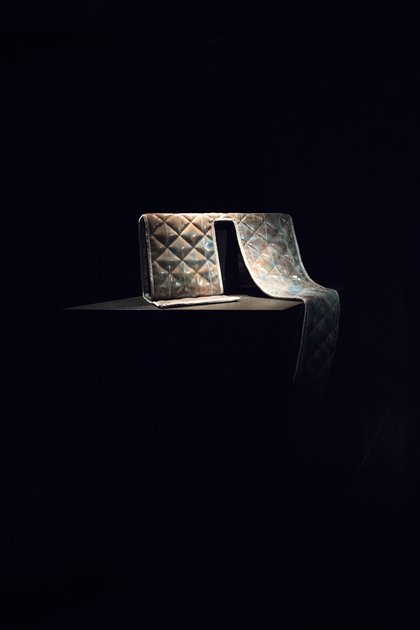-
From Current Issue
-
- Editor’s Letter Fire in the Heart
- Reviews I Gusti Ayu Kadek Murniasih
- Reviews 11th Seoul Mediacity Biennale: “One Escape at a Time”
- Dispatch Networked China
- One on One Monira Al Qadiri on Yukio Mishima
- Essays The rise of independent art spaces in pandemic-era Shanghai
- Features Tuan Andrew Nguyen
- Table of Contents
- Web Exclusives
- Archive
- Subscribe

R
E
V N
E
X
T
Installation view of JACQUELINE KIYOMI GORDON’s “Catchy” at Empty Gallery, Hong Kong, 2017. Courtesy Empty Gallery.
On the opening night of “Catchy,” the parents of LA-based installation artist Jacqueline Kiyomi Gordon offhandedly commented that Hong Kong’s Empty Gallery was one of the few art spaces that could earnestly present their daughter’s work. Perhaps it was the all-black-everything interior—the key feature which sets the kunsthaus apart from its peers in the city—that provided a suitably minimal, dimly atmospheric backdrop to Gordon’s signature, precise manipulation of sound and architecture that warranted the remark. “Catchy” was Gordon’s first presentation in East Asia, and featured shifting walls, a newly composed pop song and quilts hued jade, seafoam and lavender.
A hefty speaker emitting a bass beat was set by the entrance passageway, leading visitors forward into the gallery’s upper level presentation space. An arresting set of inflated, sound-absorbing walls stood there, kept erect by pneumatic equipment for about four minutes at a time. Speakers that peppered the space emitted sounds that resembled the output of tone generators found in the laboratories of physicists. When the air pumps reversed their function and slowly let air out of the soft, black, ballooning barriers, the walls slowly glided down, losing volume and structure as if they were melting, first revealing light sources, then exposing multiple origins of sound. A song played—an earworm, a catchy tune—with saccharine, meaningless mumbles from which one could decipher: Imma love you / up and down / we go, we go, we go, as well as other lines that would not be out of place in a concert featuring Billboard’s Hot 100 songs. Around three minutes later, the song concluded, matching the common length of popular music tracks, and the barriers were filled with air again, blocking off the speakers and lights as clinical tones flooded the soundscape once more.
On the lower floor, five speakers emitted Björkian vocal notes and melodies, their angles of audio coverage guided by the gallery’s walls and blankets that were draped over metal frames that housed the custom-made equipment. Here, we heard clean tones, snippets of mumbled song lyrics and breathing sounds.
Gordon’s installation drew inspiration from recording studios where multi-channel productions are the norm and craftsmanship overshadows artistic character. The way to navigate “Catchy” was to think of the sounds from each speaker as separate channels in a single track. The vocals heard on the upper floor were the main lyrics; the bass beat could be heard by the entrance; vocal harmonies and other electronic instrumental sounds were downstairs, ripped apart and spewed forth by five directional speakers placed in different locations, towards different directions, steered further by quilts with flighty, subtle shades of pastels made by the artist. By isolating the sounds that form a single pop music track, Gordon turned the two floors that comprise the gallery into a song, folding the aural dimension into the art space’s architecture. To hear the music, one must step through the space: first the narrow pass past the entrance, followed by Gordon’s maze, down the stairs, and then into and out of three smaller rooms. While the artist appropriated the language and production techniques of pop music, her composition was never presented as a single unit, and therefore could never be heard in full. Unlike a standard pop music track, visitors were only offered one or two layers at any given spot, at any given time.
The effect of Gordon’s site-specific installation is one of detemporization or a reconfiguration of temporal measurement. Within Empty Gallery’s black halls—particularly inside Gordon’s labyrinth of inflatable walls—our appraisal of time was no longer the consequence of Mesopotamian construction, but shaped by the cycles that allowed light to flood the paths within the barriers and permitted song to permeate the same space.
JACQUELINE KIYOMI GORDON, Not Exactly B Flat, 2017, PVC tarpaulin walls, centrifugal blowers, Arduino microcontroller, MIDI and trigger relay, dimensions variable. Courtesy Empty Gallery, Hong Kong.
Jacqueline Kiyomi Gordon’s “Catchy” is on view at Empty Gallery, Hong Kong, until August 19, 2017.
To read more of ArtAsiaPacific’s articles, visit our Digital Library.






